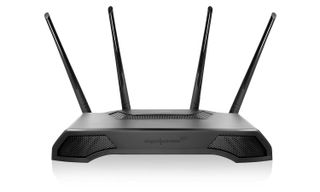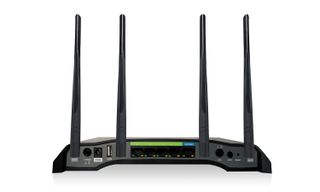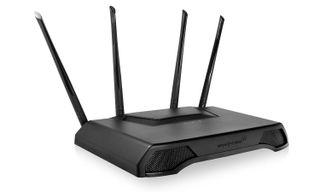Amped Wireless RTA2600 Athena — Good for Gamers
The Athena router's good looks and ability to tweak just about every operational setting will appeal to gamers, but the router lags behind others when it comes to delivering data.
Why you can trust Tom's Guide

The Amped Wireless RTA2600 Athena router ($260) combines high-performance networking with an aggressive, gamer-oriented design. It's quick to set up and offers a full range of Wi-Fi customizability, but its range fails to impress.
Design
The RTA2600 Athena looks more like a starfighter from a sci-fi movie than a piece of networking hardware.
The RTA2600 Athena looks more like a starfighter from a sci-fi movie than a piece of networking hardware. The angled sides and cutaway vents on this black plastic case should appeal to the gamer lurking within all of us. The Athena lacks the subtle sophistication of Google's OnHub tower, but it's actually one-third smaller (9.1 x 7.3 x 1.4 inches) and still sports the kind of looks that shouldn't be hidden from view.

The Athena has four screw-on antennas that you can aim depending on your environment. Rated at 5 dBi, the antennas are much more powerful than the standard stub antennas, typically rated at 3 or 4 dBi, that you get with traditional routers. With the standard RJ-SMA connector, the antennas can be changed at any time. One downside of the Athena router is that, unlike OnHub, it does not include an additional congestion antenna to monitor the network in order to avoid data traffic jams.
The Athena's indicator lights are subtler than the typical router's. Instead of eight or 10 red, yellow and green LEDs, the Athena has a line of five lights on top. These lights show the device's status: turned on, operating in the 2.4- and 5-GHz bands, connected to the Internet, or has a USB device plugged in. All the lights glow a rich blue, and you can easily turn them all off with a switch in the back.

Along the Athena's back are the antenna connections, an input connection for a broadband modem, four gigabit LAN ports and a USB slot for plugging in a memory key or hard drive. That USB slot won't work with a networked printer, though. The device also has an on/off button, a recessed reset key and a WPS button for quickly connecting a new client or device.
Inside, the Athena has a dual-core 1.4-GHz Qualcomm processor, 512MB of RAM and 128MB of flash storage to hold its firmware. Each antenna has four dedicated amplifiers, one for boosting the signal for incoming and outgoing traffic on each band.
Setup Software
After screwing in the antennas and plugging in the Athena, you'll need to connect a device to the router. Unlike OnHub, which can be configured only with an Android or iOS app, Athena can connect to other types of devices, such as a desktop PC or a Mac.
The Athena router is one of the most customizable pieces of networking gear, making it a geek's dream come true.
The router's startup wizard takes about 20 seconds to scope out your Internet connection and gives you the option of changing the network's name and passwords (something you should do immediately, because the Athena uses generic network names and passwords out of the box). All told, it took me 5 minutes to set up this router.
MORE: Best Routers
Configuration
The Athena router is one of the most versatile and customizable pieces of networking gear you can buy, making it a geek's dream come true. To check on its settings or change anything, you need to go to the router's dashboard, available at the router's IP address or — after its initial configuration — via setup.ampedwireless.com.
In addition to using IP V.6 addressing (which someday we'll all have to use), you can do things like turn off the router's 2.4- or 5-GHz transmission. In other words, you can turn it into a wired-only router for when you go on vacation. You can even set up an access schedule for when the wireless transmissions are turned on and off.
Amped's Athena router can customize a number of different settings – everything from the Beacon Interval for determining the time between beacon broadcasts to the fragmentation threshold that sets the maximum packet size. All of this allows you to optimize the router for how you plan to use it. Unlike most of its competitors, the Athena allows you to adjust its power so you're not broadcasting past the walls of your abode. It can also use Wi-Fi Protected Setup to automatically allow devices to connect.

The Athena has the latest security software, with the ability to use anything from WEP to WPA2 encryption. It's also the rare router in its class that can use a Radius server to authenticate clients, making it safe for a small business to use. It has a stateful packet inspection firewall (though, unfortunately, not a network address translation one) to help distinguish legitimate traffic from hackers.
One downside is that the Athena won't automatically download firmware updates as they become available, though it took about 5 minutes to download and install the latest software. The router lacks the OnHub's ability to run only approved software when it's starting up, which would prevent rogue software from taking over the device.
Over the course of two weeks, I used the Athena router to connect to a wide variety of devices, including a Microsoft Surface 3 tablet, an elderly three-year-old MacBook Air, an iPad mini and an Android phone. The router can create four separate guest networks, each with different use and access rights.
The router works with versions of Amped's Wi-Fi Analytics Tool for Android and Windows to monitor the network; there's no comparable analytics tool for Mac or iOS users. The software not only scans Athena's network for the signal strength for each band, but also looks for interfering networks. With some of the coolest networking graphs available for looking at throughput over time or spotting interfering channels, it's a shame that you can't use it to make any changes to the router's settings.
Performance
The dual-band Athena router can theoretically push 2.35 Gbps of data over the 2.4- and 5-GHz bands. Of that, 600 Mbps flows through 2.4-GHz transmissions, and 1.743 Gbps goes through the 5-GHz section. A 1.4-GHz Qualcomm dual-core processor with 512MB of RAM and 128MB of storage powers the router.
Based on Qualcomm's MU EFX line of radio chips, the Athena uses the latest beamforming techniques to adapt its transmissions to suit its clients. It also includes MU-MIMO technology for when everyone at home demands bandwidth at the same time.

In real-world testing using Ixia's IxChariot software in a crowded Wi-Fi environment, the Athena router was powerful but just short of the upper echelon of networking gear we've evaluated. It was able to move 73.6 Mbps in 2.4-GHz mode as well as 329.2 Mbps in 5-GHz mode. That adds up to a total throughput of 402.8 Mbps, which is well above the category average of 348 Mbps.
The Athena's performance trailed that of the $130 TrendNet TEW-812DRU (at a peak of 442.9 Mbps) and the $200 Netgear R7000 (at a peak of 444.8 Mbps), each of which costs less than the Amped Athena.
Interestingly, the Athena hit its peak throughput when it was 15 feet from the connected device. That differs from competing routers, which usually have the highest throughput when connecting devices are located closer to the router.
Its latency — the time it takes to get a data packet from the router to its destination and back — was a little on the high side, at 16 milliseconds and 4.6 ms in 2.4- and 5-GHz operations, respectively. The router had good range; it didn't lose touch with my Surface 3 tablet until it was 110 feet away, in a suburban home with lots of walls. That's well short of the 175-foot range of its little brother, the RTA1750, but it should be plenty to fill most homes.
MORE: Google's Wi-Fi Router Could Make Your Home Smarter
The Athena router easily passed our saturation test, where we play a TV show on one system while watching a movie on another and listening to Internet radio on a third. All this happens while two desktops swap a load of data. The video and audio flowed smoothly, with no stuttering or frozen frames during the test.
Warranty
Amped Wireless' Athena comes with a one-year warranty that seems to be standard for routers these days. Still, that pales in comparison to the three years of coverage — about the expected technological lifetime of a router — that TrendNet provides with its routers.
Bottom Line
Amped Wireless' Athena may not be the most powerful router or the one with the longest range, but it's one of the most customizable, with a wide variety of adjustments possible for delivering peak performance. It also has one of the best mobile apps for a Wi-Fi router in Amped's Wi-Fi Analytics Tool, which lets you monitor many important aspects of its operations, though you can't change any settings from there.
The Athena boasts both quick setup and high-gain antennas, but it doesn't get beyond a mediocre range of 110 feet. And its $260 price tag is more in line with that of flagship tri-band routers that can push more data to connected devices than this router could muster.
Specs
Wi-Fi Spec: 802.11ac/Dual Band
Number of Antennas/Removable: 4/Yes
Ports: 4 Gbps LAN, USB 3.0
Peak 802.11ac performance: 402.8 Mbps (at 15 feet)
Range: 110 feet
Size: 1.4 x 9.1 x 7.3 inches
Sign up to get the BEST of Tom’s Guide direct to your inbox.
Upgrade your life with a daily dose of the biggest tech news, lifestyle hacks and our curated analysis. Be the first to know about cutting-edge gadgets and the hottest deals.
Brian Nadel is a freelance writer and editor who specializes in technology reporting and reviewing. He works out of the suburban New York City area and has covered topics from nuclear power plants and Wi-Fi routers to cars and tablets. The former editor-in-chief of Mobile Computing and Communications, Nadel is the recipient of the TransPacific Writing Award.

